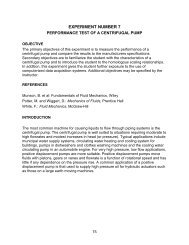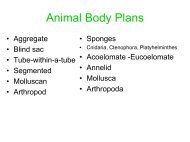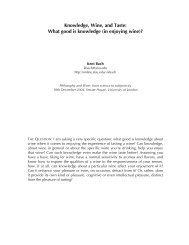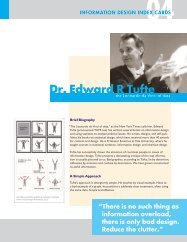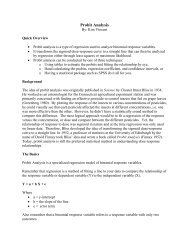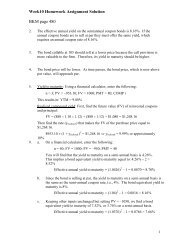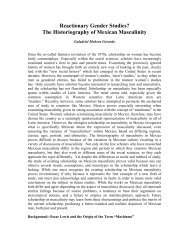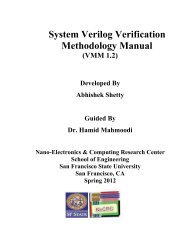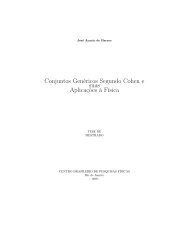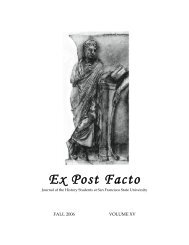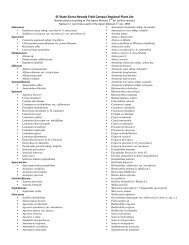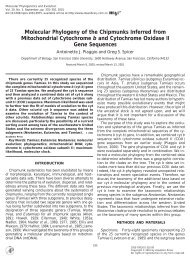An Annotated Bibliography of Similarity Indices in Ecology Cynthia ...
An Annotated Bibliography of Similarity Indices in Ecology Cynthia ...
An Annotated Bibliography of Similarity Indices in Ecology Cynthia ...
You also want an ePaper? Increase the reach of your titles
YUMPU automatically turns print PDFs into web optimized ePapers that Google loves.
<strong>An</strong> <strong>An</strong>notated <strong>Bibliography</strong> <strong>of</strong> <strong>Similarity</strong> <strong>Indices</strong> <strong>in</strong> <strong>Ecology</strong><br />
<strong>Cynthia</strong> Fenter and Summer L<strong>in</strong>dzey<br />
Papers are divided <strong>in</strong>to three parts: Part 1 – <strong>Similarity</strong> Metrics: Approaches and Critiques; Part II<br />
–Detect<strong>in</strong>g Change <strong>in</strong> Community Structure: <strong>An</strong>alytic and Statistical Approaches; Part III –<br />
Applications <strong>of</strong> <strong>Similarity</strong> <strong>Indices</strong>.<br />
I. <strong>Similarity</strong> Metrics: Approaches and Critiques<br />
Baroni-Urbani, C., and M.W. Buser. (1976) <strong>Similarity</strong> <strong>of</strong> b<strong>in</strong>ary data. Syst. Zool. 25:251-<br />
259.<br />
The authors depart from convention by <strong>in</strong>corporat<strong>in</strong>g the mutual absence <strong>of</strong> species, not<br />
just their presence, between two samples <strong>in</strong> a calculation <strong>of</strong> their compositional or<br />
phylogenic similarity. Such “negative matches” are <strong>of</strong>ten excluded from similarity<br />
<strong>in</strong>dices because their <strong>in</strong>terpretation is thought to be too ambiguous. These authors argue<br />
that shared absences and the frequency <strong>of</strong> rare characters or species are crucial to<br />
characteriz<strong>in</strong>g similarity, because negative matches are critical parameters <strong>of</strong> the<br />
statistical distribution <strong>of</strong> characters/species abundances across all samples or <strong>in</strong>dividuals.<br />
They derive their arguments mathematically <strong>in</strong> a brief appendix.<br />
Bloom, S.A. (1981) <strong>Similarity</strong> <strong>in</strong>dices <strong>in</strong> community studies: potential pitfalls. Mar<strong>in</strong>e<br />
<strong>Ecology</strong> – Progress Series 5: 125-128.<br />
This short note serves as a warn<strong>in</strong>g to ecologists who are <strong>in</strong>terested <strong>in</strong> us<strong>in</strong>g similarity<br />
<strong>in</strong>dices to compare community composition between sites because over- or underestimation<br />
<strong>of</strong> many <strong>in</strong>dices. The author suggests justify<strong>in</strong>g the use <strong>of</strong> a chosen <strong>in</strong>dex for<br />
any study and recommends us<strong>in</strong>g Czekanowski’s Quantitative Index (a.k.a. Sörenson) as<br />
the <strong>in</strong>dex that most accurately revealed similarity between samples. A couple <strong>of</strong> cautions<br />
about this paper, first, the author doesn’t use data to compare each <strong>in</strong>dex, but <strong>in</strong>stead uses<br />
response curves for each to see how and where each curve overlaps. Second, and possibly<br />
more important, the curves are normal distribution curves, but species abundances do not<br />
follow a normal distribution therefore, the author’s comparisons may be bogus.<br />
Bray, J.R., and J.T. Curtis. (1957) <strong>An</strong> ord<strong>in</strong>ation <strong>of</strong> the upland forest communities <strong>of</strong><br />
southern Wiscons<strong>in</strong>. Ecological Monographs 27(4): 325-349.<br />
This paper is always cited when authors use their <strong>in</strong>dex <strong>of</strong> similarity. It is doubtful that<br />
any author has actually read the paper; however, Bray and Curtis developed the <strong>in</strong>dex<br />
ultimately to perform an ord<strong>in</strong>ation analysis on plant community data gathered <strong>in</strong> S.<br />
Wiscons<strong>in</strong> to reveal forest community structure (another attempt at resolv<strong>in</strong>g Clements-<br />
Gleason debate). It is worth read<strong>in</strong>g if just for the image <strong>of</strong> the hand-built threedimensional<br />
ord<strong>in</strong>ation model.<br />
Cao, Y., and D.P. Larsen. (2001) Rare species <strong>in</strong> multivariate analysis for bioassessment:<br />
some considerations. Journal <strong>of</strong> the North American Benthological Society 20(1):<br />
144-153.<br />
In keep<strong>in</strong>g with their other papers, this <strong>in</strong>vestigation illustrates how sensitive similarity<br />
<strong>in</strong>dices and multivariate comparisons are to sample size. The role <strong>of</strong> rare – or more aptly
arely detected --species <strong>in</strong> chang<strong>in</strong>g the results <strong>of</strong> multivariate similarity analysis is<br />
considered <strong>in</strong> detail.<br />
Cao, Y., D.P. Larsen, R.M. Hughes, P.L. <strong>An</strong>germeier, and T.M. Patton. (2002) Sampl<strong>in</strong>g<br />
effort affects multivariate comparisons <strong>of</strong> streams assemblages. Journal <strong>of</strong> the North<br />
American Benthological Society 21(4): 701-714.<br />
Cao et al use three data sets (1 <strong>of</strong> benthic <strong>in</strong>vertebrates, 2 <strong>of</strong> fish) to document the high<br />
degree to which sampl<strong>in</strong>g effort changes the outcome <strong>of</strong> multivariate techniques --which<br />
rely on similarity <strong>in</strong>dices to describe differences between communities. This is one <strong>of</strong> the<br />
first papers to <strong>in</strong>vestigate the behavior <strong>of</strong> both similarity metrics and their complicated<br />
modern <strong>in</strong>carnations, the ord<strong>in</strong>ation and cluster<strong>in</strong>g techniques. Ord<strong>in</strong>ators beware:<br />
gett<strong>in</strong>g a stable, or reliable, description <strong>of</strong> community differences was not possible<br />
without <strong>in</strong>tensive sampl<strong>in</strong>g.<br />
Cao, Y., D.D. Williams, and D.P. Larsen. (2002) Comparison <strong>of</strong> ecological communities: the<br />
problem <strong>of</strong> sample representativeness. Ecological Monographs 72(1): 41-56.<br />
Build<strong>in</strong>g on issues developed <strong>in</strong> other papers the same year, Cao et al. <strong>in</strong>vestigate the use<br />
<strong>of</strong> similarity <strong>in</strong>dices to set m<strong>in</strong>imum thresholds for sampl<strong>in</strong>g and enable accurate<br />
comparisons among communities. They argue for the use <strong>of</strong> “representative” samples <strong>in</strong><br />
compar<strong>in</strong>g species diversity and structure among different communities or sites. They<br />
devise a method <strong>of</strong> detect<strong>in</strong>g adequate representation based on <strong>in</strong>creas<strong>in</strong>g sampl<strong>in</strong>g effort<br />
until “autosimilarity” is achieved, and argue each community will require different levels<br />
<strong>of</strong> sampl<strong>in</strong>g.<br />
Chao, A., W-H Hwang, Y-C Chen, and C-Y Kuo. (2000) Estimat<strong>in</strong>g the number <strong>of</strong> shared<br />
species <strong>in</strong> two communities. Statistica S<strong>in</strong>ica 10: 227-246.<br />
These authors attempt to improve estimates <strong>of</strong> community similarity by account<strong>in</strong>g for<br />
the number <strong>of</strong> undetected, but shared, species <strong>in</strong> a sample. They describe <strong>in</strong> detail the<br />
statistical acrobatics <strong>in</strong>volved <strong>in</strong> estimat<strong>in</strong>g the degree to which a sample is <strong>in</strong>complete<br />
and how to adjust a sample ad hoc for the probability it has missed any shared species.<br />
They suggest us<strong>in</strong>g the least-frequent <strong>of</strong> the shared species <strong>in</strong> empirical data to estimate<br />
the probability <strong>of</strong> undetected shared species rema<strong>in</strong><strong>in</strong>g <strong>in</strong> the communities. However,<br />
because the model is developed from the sample data itself, it does not seem to me to be<br />
externally valid or a complete reference distribution to judge the adequacy <strong>of</strong> a sampl<strong>in</strong>g<br />
technique. The reference distribution (the model <strong>of</strong> detection probabilities) is pr<strong>in</strong>cipally<br />
based on, and therefore limited by, sampl<strong>in</strong>g effort, not necessarily on the biological<br />
behavior <strong>of</strong> the organisms <strong>in</strong>volved. Time spent estimat<strong>in</strong>g how <strong>in</strong>adequate a sample is<br />
could better be spent <strong>in</strong> the field gather<strong>in</strong>g more data and uncover<strong>in</strong>g hard to detect<br />
species – or whether they were just overlooked.<br />
Chao, A., R.L. Chazdon, R.K. Colwell, and T-J Shen. (2005) A new statistical approach for<br />
assess<strong>in</strong>g similarity <strong>of</strong> species composition with <strong>in</strong>cidence and abundance data.<br />
<strong>Ecology</strong> Letters 8: 148-159.<br />
The authors ref<strong>in</strong>e the earlier approach <strong>of</strong> Cao et al (2000) to develop a correction factor<br />
for a particular class <strong>of</strong> similarity <strong>in</strong>dices, the Jaccard and Sorensen <strong>in</strong>dices. Aga<strong>in</strong>, the<br />
<strong>in</strong>cidence and abundance <strong>of</strong> species <strong>in</strong> a given sample is used to estimate the number <strong>of</strong>
“missed” couples. This method derives corrections from the distribution <strong>of</strong> even less<br />
frequent matches than the earlier work, def<strong>in</strong><strong>in</strong>g “rare” matches as those that occur only<br />
once or twice <strong>in</strong> a given pair <strong>of</strong> samples. Like diversity estimators, this method<br />
represents a quantitative fudge-factor that can not redress deficiencies <strong>in</strong> experimental<br />
design (sampl<strong>in</strong>g) or analysis.<br />
Connor, E.F and D. Simberl<strong>of</strong>f (1978) Species number and compositional similarity <strong>of</strong> the<br />
Galapagos flora and avifauna. Ecological Monographs 48: 219-248. Connor and<br />
Simberl<strong>of</strong>f provide a comprehensive review <strong>of</strong> the experimental issues <strong>in</strong>volved <strong>in</strong><br />
draw<strong>in</strong>g conclusions about species richness and compositional overlap <strong>in</strong> the Galapagos<br />
Islands. The section on similarity <strong>in</strong>dices stands as one <strong>of</strong> the most accessible and<br />
ecologically motivated treatments <strong>of</strong> the subject and effectively <strong>in</strong>structs the reader on the<br />
statistical and conceptual limitations these <strong>in</strong>dices have. Most importantly, it explicitly<br />
addresses the lack <strong>of</strong> null hypotheses <strong>in</strong> similarity comparisons, answer<strong>in</strong>g the question:<br />
What do we expect to f<strong>in</strong>d and why?<br />
Faith, D.P., P.R. M<strong>in</strong>ch<strong>in</strong> and L. Belb<strong>in</strong>. (1987) Compositional dissimilarity as a robust<br />
measure <strong>of</strong> ecological distance. Vegetatio 69: 57-68.<br />
The authors report their results <strong>of</strong> test<strong>in</strong>g the performance <strong>of</strong> different similarity <strong>in</strong>dices<br />
<strong>in</strong> represent<strong>in</strong>g another metric, “ecological distance”. Ecological distance is not def<strong>in</strong>ed<br />
biologically but as the multidimensional space that separates two samples, sites or<br />
communities. Species abundances are used to construct the multidimensional coord<strong>in</strong>ates<br />
that def<strong>in</strong>e ecological distance. They f<strong>in</strong>d the Bray-Curtis (dis-)similarity metric to best<br />
approximate ecological distance, and as a result many researchers have taken up the<br />
<strong>in</strong>dex <strong>in</strong> their <strong>in</strong>vestigations, such as for the ANOSIM algorithm. Regardless <strong>of</strong> its<br />
ability to capture their abstract def<strong>in</strong>ition <strong>of</strong> ecological distance, Wolda’s tests rem<strong>in</strong>d us<br />
that the <strong>in</strong>dex can be extremely biased under conditions <strong>of</strong> small sample size and low<br />
sample effort.<br />
Grassle, J.F., and W. Smith. (1976) A similarity measure sensitive to the contribution <strong>of</strong><br />
rare species and its use <strong>in</strong> <strong>in</strong>vestigation <strong>of</strong> variation <strong>in</strong> mar<strong>in</strong>e benthic communities.<br />
Oecologica 25:13-22.<br />
Grassle and Smith attempt to rectify the bias and subjectivity <strong>in</strong> typical similarity <strong>in</strong>dices<br />
by bas<strong>in</strong>g their comparisons on underly<strong>in</strong>g biology and species pool available to<br />
communities. The derive a measure <strong>of</strong> expected species shared by formulat<strong>in</strong>g the<br />
probability that multiple sampl<strong>in</strong>g draws <strong>of</strong> a given size will eventually lead an average,<br />
or expected, number <strong>of</strong> shared species. Their measure is a generalization <strong>of</strong> Morisita’s<br />
<strong>in</strong>dex.<br />
Horn, H., (1966) Measurement <strong>of</strong> “overlap” <strong>in</strong> comparative ecological studies. The<br />
American Naturalist 100(914): 419-424.<br />
Horn simplifies Morisita’s <strong>in</strong>dex and uses it to quantify degree <strong>of</strong> niche overlap between<br />
species <strong>in</strong> a community. He and others attempts to use similarity as evidence that<br />
competitive relationships structure communities’ species composition.
Huhta, V., (1979) Evaluation <strong>of</strong> different similarity <strong>in</strong>dices as measures <strong>of</strong> succession <strong>in</strong><br />
Arthropod communities <strong>of</strong> the forest floor after clear-cutt<strong>in</strong>g. Oecologia 41: 11-23.<br />
Huhta compares the performance <strong>of</strong> 16 different similarity <strong>in</strong>dices <strong>in</strong> captur<strong>in</strong>g the<br />
successional change noticed by the author <strong>in</strong> beetle and spider communities after<br />
dramatic habitat alteration. Interest<strong>in</strong>gly, one <strong>of</strong> the most <strong>of</strong>ten recommended <strong>in</strong>dices,<br />
Morisita’s “C”, failed to reveal the alleged change <strong>in</strong> the animal communities. However,<br />
it is not clear if the results are artifacts <strong>of</strong> sampl<strong>in</strong>g or truly reflect a lack <strong>of</strong> change <strong>in</strong><br />
community structure.<br />
Izsak, J., (1999) Notes on asymmetrical similarity <strong>in</strong>dices. Oikos 84(2): 343-345.<br />
Izsak expands and ref<strong>in</strong>es Kun<strong>in</strong>’s proposed <strong>in</strong>dex. A heavily jargon-laden statistical<br />
treatment that is not very accessible.<br />
Krebs, Charles. 1999. “ <strong>Similarity</strong> Coefficients and Cluster <strong>An</strong>alysis,” pp. 375-393,<strong>in</strong><br />
Ecological Methodology, 2 nd ed. Menlo Park: Addison Wesley Longman, Inc.<br />
Brief, accessible <strong>in</strong>troduction to the most common types <strong>of</strong> similarity <strong>in</strong>dices and the<br />
authors who have developed them. <strong>An</strong> excellent resource for clarify<strong>in</strong>g possible uses and<br />
relevance <strong>of</strong> different <strong>in</strong>dices.<br />
Kun<strong>in</strong>, W.E. (1995) Towards an asymmetric <strong>in</strong>dex <strong>of</strong> community similarity. Oikos 73(3):<br />
442-446.<br />
Kun<strong>in</strong> takes a novel approach towards similarity <strong>in</strong>dices and derives a probability metric<br />
that <strong>in</strong>tentionally changes value accord<strong>in</strong>g to the focal po<strong>in</strong>t (sample or plot) <strong>of</strong><br />
observation. His metric is derived from the highly-esteemed Morisita <strong>in</strong>dex. Many<br />
probability based <strong>in</strong>dices calculate similarity based on the likelihood <strong>of</strong> draw<strong>in</strong>g two<br />
identical species or <strong>in</strong>dividuals simultaneously from either a) a hypothesized regional<br />
pool <strong>of</strong> species or b) a local pool represented by the two samples/communities be<strong>in</strong>g<br />
compared. Kun<strong>in</strong> derives a slightly different probability, that <strong>of</strong> draw<strong>in</strong>g an identical<br />
species <strong>in</strong> a separate sampl<strong>in</strong>g event, from another, second sample. Kun<strong>in</strong> contends that<br />
this <strong>in</strong>dependent sampl<strong>in</strong>g model <strong>of</strong> shared species will more accurately detect and reflect<br />
nested subsets among communities, and therefore be useful <strong>in</strong> assess<strong>in</strong>g the “<strong>in</strong>vasibility”<br />
<strong>of</strong> neighbor<strong>in</strong>g plots. This metric has eluded common use <strong>in</strong> the literature.<br />
Legendre, P. and L. Legendre. (1998) Numerical <strong>Ecology</strong>, 2 nd ed. New York: Elsevier.<br />
These two prom<strong>in</strong>ent statistical ecologists devote an entire chapter to def<strong>in</strong><strong>in</strong>g ecological<br />
“resemblance” and the coefficients used to measure it. This is not a chapter for the<br />
statistically fa<strong>in</strong>t <strong>of</strong> heart, but is an essential resource for anyone who will spend a lot <strong>of</strong><br />
time <strong>in</strong>vestigat<strong>in</strong>g community structure and composition.<br />
Norris, K.C., (1999) Quantify<strong>in</strong>g change through time <strong>in</strong> spider assemblages: sampl<strong>in</strong>g<br />
methods, <strong>in</strong>dices and sources <strong>of</strong> error. Journal <strong>of</strong> Insect Conservation 3: 309-325.<br />
Like Huhta’s exam<strong>in</strong>ation <strong>of</strong> spiders and beetles, Norris applies a multitude <strong>of</strong> <strong>in</strong>dices to<br />
data she collected on spiders <strong>in</strong> an eastern deciduous forest and compares their<br />
performance. Like Huhta and Wolda, Norris f<strong>in</strong>ds that <strong>in</strong>dices are very sensitive to<br />
sample size, sample effort and underly<strong>in</strong>g diversity <strong>of</strong> the samples and communities
e<strong>in</strong>g compared. None are very well-behaved or reliable, but she has a few noteworthy<br />
recommendations and comments.<br />
Phillippi, T.E., P.M. Dixon, and B.E. Taylor. (1998) Detect<strong>in</strong>g trends <strong>in</strong> species<br />
composition. Ecological Applications 8(2): 300-308.<br />
The authors <strong>of</strong> this paper use zooplankton and bird data to employ ways <strong>of</strong> test<strong>in</strong>g<br />
community dissimilarity over time and between sites. The authors suggest that<br />
dissimilarity measures are the most appropriate for monitor<strong>in</strong>g changes <strong>in</strong> species<br />
composition over time. They propose a way to def<strong>in</strong>e trends <strong>of</strong> change <strong>in</strong> species over<br />
time as ‘progressive change’- the dissimilarity <strong>in</strong> species composition between two<br />
samples tends to <strong>in</strong>crease over time. The authors next outl<strong>in</strong>e ways to test progressive<br />
change us<strong>in</strong>g Kendall’s tau correlation, Spearman’s rank correlation and a Mantel test.<br />
They use Bray-Curtis metric to calculate dissimilarity for both data sets and f<strong>in</strong>d no<br />
evidence <strong>of</strong> progressive change for the zooplankton data, but a trend is detected <strong>in</strong> the<br />
bird data. Make an argument for us<strong>in</strong>g permanent plots <strong>in</strong> monitor<strong>in</strong>g designs to detect<br />
trends <strong>in</strong> community change, but don’t address whether permanent plots are always<br />
biologically appropriate.<br />
Plotk<strong>in</strong>, J.B., and H.C. Muller-Landau. (2002) Sampl<strong>in</strong>g the species composition <strong>of</strong> a<br />
landscape. <strong>Ecology</strong> 83(12): 3344-3356.<br />
The authors put the reliability and accuracy <strong>of</strong> similarity <strong>in</strong>dices <strong>in</strong> biological context.<br />
They aptly demonstrate how spatial aggregation and abundance distribution <strong>of</strong> species<br />
can dramatically affect <strong>in</strong>dices <strong>of</strong> community composition, and how to consider these<br />
parameters <strong>in</strong> the formulation <strong>of</strong> community comparisons. This is an excellent resource<br />
for fram<strong>in</strong>g the use and misuse <strong>of</strong> similarity <strong>in</strong>dices and for develop<strong>in</strong>g ecologically<br />
sound models <strong>of</strong> compositional overlap.<br />
Potts, J.M. (1998) <strong>An</strong> alternative asymmetric <strong>in</strong>dex <strong>of</strong> community similarity. Oikos 82(2):<br />
395-396.<br />
Potts attempts to improve on the <strong>in</strong>dex proposed by Kun<strong>in</strong> (see above) by improv<strong>in</strong>g its<br />
“behavior” (i.e., tendency to give different results for the same data set). However, as she<br />
notes, her improvement fails to escape from a common problem among similarity<br />
metrics: their lack <strong>of</strong> <strong>in</strong>dependence from sample size and diversity.<br />
Simberl<strong>of</strong>f, D.S. and E.F. Connor. (1979) Q-mode and R-mode analyses <strong>of</strong> biogeographic<br />
distributions: null hypotheses based on random colonization. Patil and Rosenzweig<br />
eds. Contemporary Quantitative <strong>Ecology</strong> and Related Ecometrics, pp123-138.<br />
International Co-operative Publish<strong>in</strong>g House, Fairland, Maryland.<br />
Connor and Simberl<strong>of</strong>f derive a similarity <strong>in</strong>dex based on the degree <strong>of</strong> deviation <strong>of</strong> the<br />
number <strong>of</strong> shared species at two given sites from that expected under a specified null<br />
hypothesis. Thus, the <strong>in</strong>dex is relative (or “probabilisitic”) and provides a means <strong>of</strong><br />
<strong>in</strong>ference. The authors provide a simple, yet <strong>in</strong>structive example from the Galapagos<br />
Island avifauna that sheds light on both the statistical and biological issues <strong>in</strong>volved <strong>in</strong><br />
us<strong>in</strong>g similarity <strong>in</strong>dices.
Smith, W. (1989) ANOVA-like similarity analysis us<strong>in</strong>g expected species shared. Biometrics<br />
45: 873-881.<br />
Smith derives a “similarity” <strong>in</strong>dex by measur<strong>in</strong>g the expected number <strong>of</strong> species shared<br />
by two collections or samples. Expected species shared are derived from the probability<br />
<strong>of</strong> draw<strong>in</strong>g shared species from a specified population model. The observed species<br />
shared between two samples are compared to that expected when draw<strong>in</strong>g two samples<br />
from the same community; deviation from the expectation then provides evidence <strong>of</strong><br />
variation, hence change. Smith proposes a method to decompose the variation <strong>in</strong> the<br />
deviation <strong>in</strong>to its primary sources, thus reveal<strong>in</strong>g factors beyond random colonization that<br />
are responsible for structur<strong>in</strong>g communities.<br />
.<br />
Streever, W.J. and S.A. Bloom. (1993) The self-similarity curve: a new method <strong>of</strong><br />
determ<strong>in</strong><strong>in</strong>g the sampl<strong>in</strong>g effort required to characterize communities. Journal <strong>of</strong><br />
Freshwater <strong>Ecology</strong> 8(4): 401-403.<br />
This short paper is one <strong>of</strong> the first that proposes a way to first f<strong>in</strong>d out how similar the<br />
samples gathered at a particular site are to each other. The goal <strong>of</strong> this method is to test<br />
for sufficient sampl<strong>in</strong>g. If the samples taken at a site are not very similar to each other<br />
greater sampl<strong>in</strong>g effort is suggested before test<strong>in</strong>g for similarity between sites(also see<br />
Cao et al. (2002)).<br />
Tamas, J., J. Podani, and P. Csontos. (2001) <strong>An</strong> extension <strong>of</strong> presence/absence coefficients<br />
to abundance data: a new look at absence. Journal <strong>of</strong> Vegetation Science 12: 401-<br />
410.<br />
The authors develop a method for <strong>in</strong>clud<strong>in</strong>g and quantify<strong>in</strong>g “absence” data <strong>in</strong> vegetation<br />
samples and how this affects similarity <strong>in</strong>dices. They then explore the effect these<br />
revised measurements have on ord<strong>in</strong>ation and vegetation classification. The authors<br />
argue that their <strong>in</strong>dex allows for more methodological flexibility, without compromis<strong>in</strong>g<br />
rigor.<br />
Wolda, H., (1981) <strong>Similarity</strong> <strong>in</strong>dices, sample size, and diversity. Oecologia 50: 296-302.<br />
Wolda presents and tests 22 similarity <strong>in</strong>dices for effects <strong>of</strong> sample size and diversity on<br />
the robustness <strong>of</strong> each test. Simulates populations and takes random samples <strong>of</strong> different<br />
sizes from four different diversities <strong>of</strong> log normally distributed <strong>in</strong>sect fauna. The author<br />
f<strong>in</strong>ds Morisita’s <strong>in</strong>dex to be <strong>in</strong>dependent <strong>of</strong> sample size and diversity and makes<br />
recommendations for the use <strong>of</strong> many <strong>of</strong> the other <strong>in</strong>dices tests. This paper is<br />
recommended for anyone <strong>in</strong>terested <strong>in</strong> us<strong>in</strong>g similarity <strong>in</strong>dices as a good start<strong>in</strong>g po<strong>in</strong>t for<br />
choos<strong>in</strong>g an <strong>in</strong>dex to use, and is the most <strong>of</strong>ten cited reference <strong>in</strong> contemporary use <strong>of</strong><br />
similarity <strong>in</strong>dices.<br />
II. Detect<strong>in</strong>g Changes <strong>in</strong> Community Composition: <strong>An</strong>alytic/Statistical Techniques<br />
<strong>An</strong>derson, Marti J. (2001) A new method for non-parametric multivariate analysis <strong>of</strong><br />
variance. Austral <strong>Ecology</strong> 26: 32-46.<br />
<strong>An</strong>derson describes a statistical approach for assess<strong>in</strong>g the statistical significance <strong>of</strong><br />
differences <strong>in</strong> species assemblages among sites, not just describ<strong>in</strong>g the differences as
most similarity <strong>in</strong>dices do. The technique is very similar to the <strong>in</strong>creas<strong>in</strong>gly popular<br />
“ANOSIM” program employed by mar<strong>in</strong>e ecologists and develops a similar “F” statistic.<br />
A good review <strong>of</strong> statistical issues <strong>in</strong>volved <strong>in</strong> the model<strong>in</strong>g and test<strong>in</strong>g <strong>of</strong> the nonnormal,<br />
multivariate data that comprise community data sets.<br />
Clarke, K.R. (1993) Non-parametric multivariate analysis <strong>of</strong> changes <strong>in</strong> community<br />
structure. Australian Journal <strong>of</strong> <strong>Ecology</strong> 18: 117-143.<br />
Build<strong>in</strong>g on the work <strong>of</strong> Smith et al (1990) and recommendations <strong>of</strong> Faith et al., Clarke<br />
develops a statistic, Clarke’s R, that can be used to assess the significance <strong>of</strong> between to<br />
with<strong>in</strong>-site variation <strong>in</strong> species abundances. Its conceptual goal is similar to the F<br />
statistic used <strong>in</strong> ANOVA, and hence has been co<strong>in</strong>ed “ANOSIM”. ANOSIM employs<br />
the Bray-Curtis similarity measure, largely based on the recommendation <strong>of</strong> Faith et al<br />
(1987) it seems, but certa<strong>in</strong>ly other measures may prove useful.<br />
Smith, E.P., K.W. Pontasch and J.Carns Jr. (1990) Community similarity and the analysis<br />
<strong>of</strong> multispecies environmental data: a unified statistical approach. Wat. Res. 24(4)<br />
507-514.<br />
This research represents one <strong>of</strong> the first attempts to derive an analytic approach to<br />
assess<strong>in</strong>g similarity <strong>in</strong> communities, rather than the descriptive approaches embodied by<br />
similarity metrics. The <strong>in</strong>terest <strong>in</strong> the research stems from the need to develop an<br />
alternative to the parametric technique MANOVA, which requires ecological data to<br />
meet assumptions they usually can not, even with transformation.<br />
As a first step Smith et al’s approach uses a similarity measure to summarize<br />
compositional differences <strong>in</strong> species abundances on two different levels (both with<strong>in</strong> sites<br />
and between sites). Second the ratio <strong>of</strong> between- to with<strong>in</strong>-site variation for these data is<br />
calculated. F<strong>in</strong>ally, similarity measures are randomly re-assigned to different replicates<br />
and sites a number <strong>of</strong> times to generate different ratios <strong>of</strong> between- to with<strong>in</strong>-site<br />
variation, and the result<strong>in</strong>g frequency distribution <strong>of</strong> possible values can be used to<br />
evaluate the relative probability <strong>of</strong> encounter<strong>in</strong>g the observed ratio. Thus, a statistical<br />
<strong>in</strong>ference can be made on the likelihood <strong>of</strong> species abundance, and therefore, community<br />
structure, vary<strong>in</strong>g between sites. This research forms the groundwork for the ANOSIM<br />
statistical s<strong>of</strong>tware developed later by mar<strong>in</strong>e ecologists Clarke and Warwick (see<br />
below).<br />
Somerfield, P.J., K.R. Clarke and F. Olsgard. (2002) A comparison <strong>of</strong> the power <strong>of</strong><br />
categorical and correlational tests applied to community ecology data from gradient<br />
studies. Journal <strong>of</strong> <strong>An</strong>imal <strong>Ecology</strong> 71: 581-593.<br />
These authors are some <strong>of</strong> the few who have <strong>in</strong>vestigated the statistical power <strong>of</strong> the<br />
recent non-parametric multivariate techniques developed to objectively and quantitatively<br />
assess differences <strong>in</strong> ecological community composition – without resort<strong>in</strong>g to the biased<br />
similarity metrics. In particular they compare the power <strong>of</strong> ANOSIM, a categorical test<br />
analogous to ANOVA, to RELATE, a correlative analogue to l<strong>in</strong>ear regression. The<br />
authors f<strong>in</strong>d that both correlative techniques are more powerful than either categorical<br />
techniques (ANOVA or ANOSIM) <strong>in</strong> their ability to detect a gradient <strong>of</strong> change <strong>in</strong><br />
community composition. Excellent review <strong>of</strong> the methods and approaches <strong>in</strong>volved <strong>in</strong><br />
analyz<strong>in</strong>g multi-species assemblages as response variables.
Solow, A.R., (1993) A simple test for change <strong>in</strong> community structure. Journal <strong>of</strong> <strong>An</strong>imal<br />
<strong>Ecology</strong> 62: 191-193.<br />
Solow demonstrates how to use resampl<strong>in</strong>g and randomization techniques to assess the<br />
significance <strong>of</strong> purported changes <strong>in</strong> community structure.<br />
Warton, D.I., and H.M. Hudson. (2004) A MANOVA statistic is just as powerful as<br />
distance-based statistics, for multivariate abundances. <strong>Ecology</strong> 85(3): 858-874.<br />
Warton and Hudson <strong>in</strong>vestigate conditions under which parametric treatments <strong>of</strong> species<br />
assemblages (like MANOVA) are as powerful as the newer, non-parametric approaches<br />
like ANOSIM and <strong>An</strong>derson’s (2001, see above). The authors’ endorsement <strong>of</strong><br />
MANOVA should be taken with a gra<strong>in</strong> <strong>of</strong> salt; they themselves provide many cases<br />
where<strong>in</strong> newer techniques are more effective and powerful.<br />
III. Some Applications <strong>of</strong> <strong>Similarity</strong> <strong>Indices</strong><br />
Azovsky, A.I. (1996) The effect <strong>of</strong> scale <strong>in</strong> congener coexistence: can molluscs and<br />
polychaetes reconcile beetles to ciliates? Oikos 77(1): 117-126.<br />
Authors utilize similarity <strong>in</strong>dices to test species coexistence theory. Read to f<strong>in</strong>d out how<br />
<strong>in</strong>dices were be<strong>in</strong>g used <strong>in</strong> (somewhat) current literature. One <strong>of</strong> very few that use<br />
similarity <strong>in</strong>dices to test any ecological mechanistic theories.<br />
Cleary, D.F.R., A.O. Mooers, K.A.O. Eichhorn, J. van Tol, R. de Jong, and S.B.J. Menken.<br />
(2004) Diversity and community compositon <strong>of</strong> butterflies and odonates <strong>in</strong>an ENSO<strong>in</strong>duced<br />
fire affected habitat mosaic: a case study from East Kalimantan, Indonesia.<br />
Oikos 105(2): 426-448.<br />
This is an application paper <strong>in</strong> which the authors compare the community composition <strong>of</strong><br />
two separate taxa <strong>in</strong> burned and unburned landscapes. The authors use a similarity matrix<br />
as part <strong>of</strong> the program PRIMER and then used the matrix for MDS ord<strong>in</strong>ation as a way to<br />
measure the differences <strong>in</strong> community structure for each landscape.<br />
Forbes, A.E. and J.M. Chase. (2002) The role <strong>of</strong> habitat connectivity and landscape<br />
geometry <strong>in</strong> experimental zooplankton metacommunities. Oikos 96(3): 433-440.<br />
The goal <strong>of</strong> this paper is to discover the effects that habitat connectivity and patch shape<br />
have on local and regional diversity. To get at the metacommunity dynamics <strong>of</strong><br />
zooplankton the authors employ percent similarity (PS) to f<strong>in</strong>d a value for beta diversity<br />
(one m<strong>in</strong>us PS). This value was then used <strong>in</strong> an ANOVA to test the effect <strong>of</strong> rate <strong>of</strong><br />
connectivity.
Gibb, H., and D. F. Hochuli. (2002) Habitat fragmentation <strong>in</strong> an urban environment: large<br />
and small fragments support different arthropod assemblages. Biological<br />
Conservation 106: 91-100.<br />
This paper uses ANOSIM (analysis <strong>of</strong> similarity—program that essentially tests for<br />
randomness <strong>of</strong> data from a similarity matrix us<strong>in</strong>g Bray-Curtis similarity <strong>in</strong>dex) to test<br />
differences <strong>in</strong> arthropod assemblages <strong>in</strong> two habitat types <strong>in</strong> various sized fragments.<br />
Izsak, J., (1999) Notes on asymmetrical similarity <strong>in</strong>dices. Oikos 84(2): 343-345.<br />
Response to Kun<strong>in</strong> (1995) Author discusses behavior <strong>of</strong> <strong>in</strong>dices related to Morisita’s<br />
<strong>in</strong>dex <strong>in</strong> which the value is asymmetric (exceed<strong>in</strong>g a value <strong>of</strong> one). Good for history <strong>of</strong><br />
asymmetric <strong>in</strong>dices <strong>in</strong> discipl<strong>in</strong>es other than ecology.<br />
Weltz<strong>in</strong>, J.F., N.Z. Muth, B. Von Holle, P.G. Cole. (2003) Genetic diversity and <strong>in</strong>visibility<br />
a test us<strong>in</strong>g a model system with a novel experimental design. Oikos 103(3): 505-518.<br />
This is another application <strong>of</strong> similarity <strong>in</strong>dices <strong>in</strong> the current literature. The authors use<br />
Jaccard’s coefficient as a way to determ<strong>in</strong>e similarity <strong>of</strong> replicate communities created as<br />
high or low-densities <strong>of</strong> Arabidopsis sp. as well as to determ<strong>in</strong>e the similarity between<br />
“levels <strong>of</strong> richness” (richness was equated with genotype). The similarity measures where<br />
used to determ<strong>in</strong>e <strong>in</strong>dependence <strong>of</strong> treatments <strong>of</strong> density and richness.



